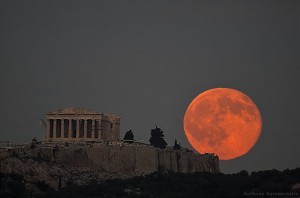In a week from today, the moon will be at its closest to earth since January 1948.
“The full moon of November 14 is not only the closest full moon of 2016,” says NASA, “but also the closest full moon to date in the 21st century.”
This means that if you miss it, you will have to wait till November 25, 2034 when the next one comes along – if you can hang on that long.
A supermoon, according to NASA, happens because the moon has an elliptical orbit, in which one side – the perigee – is about 48,280 km. closer to Earth than the other side, the apogee.
When an alignment of sun, moon and earth occurs at the stage where the perigee side of the moon is facing us and the moon happens to be on the opposite side of earth from the sun, we get what’s called a perigee-syzygy, hence a supermoon.
According to NASA, the supermoon becomes full “within about two hours of perigee, arguably making it an extra-super moon.”
This rare astronomical event is something to be over the moon about – and definitely not to be missed.
Source: sciencealert.com
Ask me anything
Explore related questions





